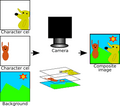Traditional animation facts for kids
Traditional animation is a classic way to make cartoons and movies move! It's different from the computer animation we see a lot today. Imagine drawing hundreds or even thousands of pictures, one by one, to make a character walk or a car drive. That's how traditional animation works! Each drawing is slightly different from the last. When these drawings are shown quickly, one after another, it creates the illusion of movement. This method takes a lot of time and effort, but it has created some of the most beloved animated films in history.
Contents
How Traditional Animation Works
Making a traditional animated movie involves many steps, from drawing to filming. Artists draw each tiny movement, and then these drawings are carefully put together.
Drawing the Scenes
First, artists create many drawings for each scene. These drawings are like flipbook pages. Each one shows a character or object in a slightly different position. Imagine a character waving their hand; an artist might draw 10 or more pictures just for that one wave!
Filming the Drawings
Once the drawings are ready, they are filmed using a special camera. In the past, a stop-motion camera would take one picture of each drawing. When all these pictures are played back quickly, it looks like the characters are moving. Not every drawing makes it into the final movie, just like not every scene filmed for a live-action movie is used.
Putting It All Together
After filming, the pictures are put in order to create the movie's story. In the old days, artists drew everything by hand. They would draw on clear sheets called cels, which helped them layer characters over backgrounds. This made the process a bit faster and easier.
The Evolution of Animation
Over time, animators found ways to make the process more efficient. This led to different styles of animation.
Limited Animation
In the 1950s, some studios started using "limited animation." This meant they used fewer drawings for each second of film. Instead of drawing every tiny movement, they might reuse drawings or only animate parts of a character, like just their mouth moving while the rest of their body stays still. This made cartoons cheaper and faster to produce.
Digital Animation Today
Today, most animated movies are made using digital animation. Artists use computers to draw, color, and move characters. This makes it much faster to create detailed scenes and special effects. Modern animated movies are usually 1 to 2 hours long and look very smooth and realistic.
Understanding Frames Per Second (FPS)
When you watch an animated movie, you're seeing many still pictures flash by very quickly. The speed at which these pictures are shown is measured in "frames per second" or FPS.
What is FPS?
FPS stands for frames per second. It tells you how many individual pictures (or "frames") are shown in one second of video. The higher the FPS, the smoother the animation looks. If the FPS is too low, the movement can look choppy or jumpy.
Common FPS Rates
Most movies, whether animated or live-action, are shown at 24 frames per second. Some modern films and video games use higher rates, like 30 or even 60 FPS, to make the action look incredibly smooth and lifelike.
Special Tools for Animators
Animators use specific tools to help them create their moving pictures.
Cels
Cels, short for celluloids, are clear, transparent sheets. In traditional animation, artists would draw and paint characters on these cels. They could then place the cels over a painted background. This allowed them to animate characters without having to redraw the background for every single frame. It was very useful for scenes with moving figures.
Sketchpads
A sketch pad is a simple but important tool. Animators use sketchpads to brainstorm ideas and draw rough versions of scenes. Sometimes, a sketchpad can even be used like a comic book or flipbook. By quickly flipping the pages, animators can see how their drawings might look when animated.
Live Video Preview
Before a scene is finalized, animators often preview their work using a "live video shower" or a similar digital tool. This lets them watch the animation as it's being made. They can test how the movements look and fix any problems or "bugs" before the final version is created.
Related pages
Images for kids
-
Painting with acrylic paint on the reverse side of an already inked cel.
-
A horse animated by rotoscoping from Eadweard Muybridge's 19th-century photos. The animation consists of 8 drawings which are "looped", i.e. repeated over and over. This example is also "shot on twos", i.e. shown at 12 drawings per second.




